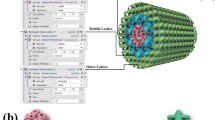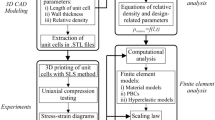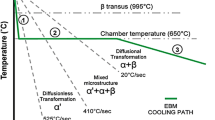Abstract
Compared with uniform structures, functionally graded lattice structures can control mechanical properties through varying structures and their volume fraction. In this study, a three-period minimal curved surface method was used to generate functional lattice structure with linear or quadratic function (LF or QF) gradient strategy in the forming direction, and the samples were fabricated by selective laser melting (SLM) using the Ti-6Al-4V metal powder. The mechanical properties, deformation behaviors, and energy absorption performance of graded lattice structures, LF, and QF I-Wrapped Package (IW-P) lattice structures were systematically investigated through experiment and finite element analysis (FEA). Based on the experimental and numerical simulation results, the LF lattice structure shows higher elastic modules and yield strength during small strain period. And the merits of performance increased layer-by-layer under large strain. Additionally, the simulation results based on Johnson-Cook and failure model show that this model can reflect structural compression deformation behavior and mechanical performance prediction. Furthermore, the elastic modulus of LF lattice structure is higher than uniform lattice structures by nearly 61.52% under the same lattice volume fraction. Compared to other lattice structures, the LF or QF lattice structures have better support performance under small strain and stronger energy absorption capacity under large strain with the same volume fraction, respectively, which shows superior potential to be applied to manufacture protective devices or vibration damping devices.













Similar content being viewed by others
Data Availability
Not applicable
Abbreviations
- t* :
-
Matrix phase region
- L :
-
Length of a lattice unit
- a :
-
TPMS function periodicities
- ρ ∗ :
-
the volume fraction
- n, m, A, B, C :
-
The model contants based on the flow stress data gained from mechanical tests.
- D 1, D 2, D 3, D 4, D 5 :
-
Johnson-Cook model constants
- σ S :
-
Equivalent stress
- ε e :
-
Equivalent plastic strain
- ε p :
-
Equivalent plastic strain rate
- ε 0 :
-
Reference equivalent plastic strain rate
- T :
-
Temperature during manufacturing
- ε f :
-
Fracture strain
- σ * :
-
Stress triaxiality
- W :
-
Energy absorption per lattice unit volume
- σ :
-
Stress
- ε :
-
Strain
- ε d :
-
Maximum strain at the onset of the densification stage
- LF:
-
Linear function
- QF:
-
Quadratic function
- SLM:
-
Selective laser melting
- IW-P:
-
I-Wrapped Package
- FEA:
-
Finite element analysis
- FGS:
-
Function graded structures
- TPMS:
-
Triply periodic minimal surfaces
- AM:
-
Additive Manufacturing
- IW-P FGS:
-
I-Wrapped Package Function graded structure
- LF IW-P:
-
Linear Function I-Wrapped Package
- QF IW-P:
-
Quadratic Function I-Wrapped Package
References
Liu Z, Zhang Y, Zhang M, Tan G, Zhu Y, Zhang Z, Ritchie RO (2019) Adaptive structural reorientation: developing extraordinary mechanical properties by constrained flexibility in natural materials. Acta Biomater 86:96–108
Ren L, Li B, Song Z, Liu Q, Ren L, Zhou X (2019) 3D printing of structural gradient soft actuators by variation of bioinspired architectures. J Mater Sci 54:6542–6551
Chen G, Luo H, Zhang Z, Fan X (2020) Flexural deformation and fracture behaviors of the sandwich turtle rib bones with hierarchical woven fibers. Colloid Interface Sci Commun 34:100230
Ott J, Lazalde M, Gu GX (2020) Algorithmic-driven design of shark denticle bioinspired structures for superior aerodynamic properties. Bioinspiration Biomimetics 15:026001
Mannan S, Paul Knox J, Basu S (2017) Correlations between axial stiffness and microstructure of a species of bamboo. R Soc Open Sci 4:160412
Zhang S, Guo J, Ma X, Peng X, Qiu Z, Ying J, Wang J (2017) Smart PDMS sponge with switchable pH-responsive wetting surface for oil/water separation. New J Chem 41:8940–8946
Frey M, Biffi G, Adobes-Vidal M, Zirkelbach M, Wang Y, Tu K, Hirt AM, Masania K, Burgert I, Keplinger T et al (2019) Adv Sci 6:1802190
Luo W, Liu H, Wang C, Qin Y, Liu Q, Wang J (2019) Bioprinting of human musculoskeletal interface. Adv Eng Mater 21:1900019
Chen D, Liu Q, Han Z, Zhang J, Song H, Wang K, Song Z, Wen S, Zhou Y, Yan C, Shi Y (2020) 4D printing strain self-sensing and temperature self-sensing integrated sensor-actuator with bioinspired gradient gaps. Adv Sci 7:2000584
Jin Y, Kong HY, Zhou XY, Li GY, Du JK (2020) Design and characterization of sheet-based gyroid porous structures with bioinspired functional gradients. Materials 13:31
Singhal P, Small W, Cosgriff-Hernandez E, Maitland DJ, Wilson TS (2014) Low density biodegradable shape memory polyurethane foams for embolic biomedical applications. Acta Biomater 10:67–76
Lee J, Chang JY (2016) Preparation of a compressible and hierarchically porous polyimide sponge via the sol-gel process of an aliphatic tetracarboxylic dianhydride and an aromatic triamine. Chem Commun (Camb) 52:10419–10422
Si Y, Yu J, Tang X, Ge J, Ding B (2014) Ultralight nanofibre-assembled cellular aerogels with superelasticity and multifunctionality. Nat Commun 5:5802
Bencherif SA, Warren Sands R, Ali OA, Li WA, Lewin SA, Braschler TM, Shih TY, Verbeke CS, Bhatta D, Dranoff G, Mooney DJ (2015) Injectable cryogel-based whole-cell cancer vaccines. Nat Commun 6:7556
Duan G, Koehn-Serrano M, Greiner A (2017) Highly efficient reusable sponge-type catalyst carriers based on short electrospun fibers. Macromol Rapid Commun 38:1600511
Jiang S, Agarwal S, Greiner A (2017) Low-density open cellular sponges as functional materials. Angew Chem Int Ed Eng 56:15520–15538
Das S, Sutradhar A (2020) Multi-physics topology optimization of functionally graded controllable porous structures: application to heat dissipating problems. Mater Des 193:108775
Kaur I, Singh P, Flow and thermal transport characteristics of triply-periodic minimal surface (TPMS)-based gyroid and Schwarz-P cellular materials, Numerical Heat Transfer Part a-Applications, 79 (2021).
Liang Y, Zhou W, Liu Y, Li Z, Yang Y, Xi H, Wu Z (2021) Energy absorption and deformation behavior of 3D printed triply periodic minimal surface stainless steel cellular structures under compression. Steel Res Int 92:2000411
Plocher J, Panesar A (2020) Effect of density and unit cell size grading on the stiffness and energy absorption of short fibre-reinforced functionally graded lattice structures. Addit Manuf 33:101171
Xiao LJ, Xu X, Song WD, Hu ML (2020) A multi-cell hybrid approach to elevate the energy absorption of micro-lattice materials. Materials 13:4083
Bharti I, Gupta N, Gupta KM (2013) Novel applications of functionally graded nano, optoelectronic and thermoelectric materials. Int J Mater Mech Manuf 1:221–224
Ataee A, Li Y, Brandt M, Wen C (2018) Ultrahigh-strength titanium gyroid scaffolds manufactured by selective laser melting (SLM) for bone implant applications. Acta Mater 158:354–368
Xu W, Lu X, Hayat MD, Tian J, Huang C, Chen M, Qu X, Wen C (2019) Fabrication and properties of newly developed Ti35Zr28Nb scaffolds fabricated by powder metallurgy for bone-tissue engineering. J Mater Res Technol 8:3696–3704
Xu W, Tian J, Liu Z, Lu X, Hayat MD, Yan Y, Li Z, Qu X, Wen C (2019) Novel porous Ti35Zr28Nb scaffolds fabricated by powder metallurgy with excellent osteointegration ability for bone-tissue engineering applications. Mater Sci Eng C Mater Biol Appl 105:110015
Vijayavenkataraman S, Kuan LY, Lu WF (2020) 3D-printed ceramic triply periodic minimal surface structures for design of functionally graded bone implants. Mater Des 191:108602
Xiao R, Feng X, Fan R, Chen S, Song J, Gao L, Lu Y (2020) 3D printing of titanium-coated gradient composite lattices for lightweight mandibular prosthesis. Compos Part B 193:108057
Jun Z, Xing A, Jianxin D, Jinghai W (2004) Thermal shock behaviors of functionally graded ceramic tool materials. J Eur Ceram Soc 24:847–854
Konyashin I, Zaitsev AA, Sidorenko D, Levashov EA, Konischev SN, Sorokin M, Hlawatschek S, Ries B, Mazilkin AA, Lauterbach S, Kleebe HJ (2017) On the mechanism of obtaining functionally graded hardmetals. Mater Lett 186:142–145
Nejad MZ, Alamzadeh N, Hadi A (2018) Thermoelastoplastic analysis of FGM rotating thick cylindrical pressure vessels in linear elastic-fully plastic condition. Compos Part B 154:410–422
Saleh B, Jiang J, Fathi R, Al-hababi T, Xu Q, Wang L, Song D, Ma A (2020) 30 Years of functionally graded materials: an overview of manufacturing methods, Applications and Future Challenges. Compos Part B 201:108376
Al-Ketan O, Lee DW, Rowshan R, Abu Al-Rub RK (2020) Functionally graded and multi-morphology sheet TPMS lattices: design, manufacturing, and mechanical properties. J Mech Behav Biomed Mater 102:103520
Bai L, Gong C, Chen X, Sun Y, Xin L, Pu H, Peng Y, Luo J (2020) Mechanical properties and energy absorption capabilities of functionally graded lattice structures: experiments and simulations. Int J Mech Sci 182:105735
Mirzaali MJ, de la Nava AH, Gunashekar D, Nouri-Goushki M, Veeger RPE, Grossman Q, Angeloni L, Ghatkesar MK, Fratila-Apachitei LE, Ruffoni D, Doubrovski EL, Zadpoor AA (2020) Mechanics of bioinspired functionally graded soft-hard composites made by multi-material 3D printing. Compos Struct 237:111867
Li D, Liao W, Dai N, Dong G, Tang Y, Xie YM (2018) Optimal design and modeling of gyroid-based functionally graded cellular structures for additive manufacturing. Comput Aided Des 104:87–99
López de Lacalle LN, Fernández A, Olvera D, Lamikiz A, Olvera D, Rodríguez C, Elias A (2011) Monitoring deep twist drilling for a rapid manufacturing of light high-strength parts. Mech Syst Signal Process 25:2745–2752
Calleja-Ochoa A, Gonzalez-Barrio H, Lopez de Lacalle N, Martinez S, Albizuri J, Lamikiz A (2021) A new approach in the design of microstructured ultralight components to achieve maximum functional performance. Materials (Basel) 14:1588
Massarwi F, Machchhar J, Antolin P, Elber G (2018) Hierarchical, random and bifurcation tiling with heterogeneity in micro-structures construction via functional composition. Comput Aided Des 102:148–159
Liu F, Mao Z, Zhang P, Zhang DZ, Jiang J, Ma Z (2018) Functionally graded porous scaffolds in multiple patterns: new design method, physical and mechanical properties. Mater Des 160:849–860
Ma Z, Zhang DZ, Liu F, Jiang J, Zhao M, Zhang T (2020) Lattice structures of Cu-Cr-Zr copper alloy by selective laser melting: microstructures, mechanical properties and energy absorption. Mater Des 187:108406
Zhou H, Zhao M, Ma Z, Zhang DZ, Fu G (2020) Sheet and network based functionally graded lattice structures manufactured by selective laser melting: design, mechanical properties, and simulation. Int J Mech Sci 175:105480
Yang L, Yan C, Cao W, Liu Z, Song B, Wen S, Zhang C, Shi Y, Yang S (2019) Compression–compression fatigue behaviour of gyroid-type triply periodic minimal surface porous structures fabricated by selective laser melting. Acta Mater 181:49–66
Jia H, Lei H, Wang P, Meng J, Li C, Zhou H, Zhang X, Fang D (2020) An experimental and numerical investigation of compressive response of designed Schwarz Primitive triply periodic minimal surface with non-uniform shell thickness. Extreme Mech Lett 37:100671
de Aquino DA, Maskery I, Longhitano GA, Jardini AL, del Conte EG (2020) Investigation of load direction on the compressive strength of additively manufactured triply periodic minimal surface scaffolds. Int J Adv Manuf Technol 109:771–779
Maskery I, Ashcroft IA (2020) The deformation and elastic anisotropy of a new gyroid-based honeycomb made by laser sintering. Addit Manuf 36:101548
Liu F, Ran Q, Zhao M, Zhang T, Zhang DZ, Su Z (2020) Additively manufactured continuous cell-size gradient porous scaffolds: pore characteristics, mechanical properties and biological responses in vitro. Materials (Basel) 13:2589
Zhao M, Zhang DZ, Liu F, Li Z, Ma Z, Ren Z (2020) Mechanical and energy absorption characteristics of additively manufactured functionally graded sheet lattice structures with minimal surfaces. Int J Mech Sci 167:105262
Zhang X, Wang J, Liu T (2021) 3D printing of polycaprolactone-based composites with diversely tunable mechanical gradients via multi-material fused deposition modeling. Compos Commun 23:100600
Wang Y, Xia J, Luo Z, Yan H, Sun J, Lu E (2020) Self-supporting topology optimization method for selective laser melting(star). Addit Manuf 36:101506
Yu G, Li Z, Li S, Zhang Q, Hua Y, Liu H, Zhao X, Dhaidhai DT, Li W, Wang X (2020) The select of internal architecture for porous Ti alloy scaffold: a compromise between mechanical properties and permeability. Mater Des 192:108754
Baroutaji A, Arjunan A, Stanford M, Robinson J, Olabi AG (2021) Deformation and energy absorption of additively manufactured functionally graded thickness thin-walled circular tubes under lateral crushing. Eng Struct 226:111324
Erdem M, Gok K, Gokce B, Gok A (2017) Numerical analysis of temperature, screwing moment and thrust force using finite element method in bone screwing process. J Mech Med Biol 17:1750016
Gök A, Demirci HI, Gök K (2014) Determination of experimental, analytical, and numerical values of tool deflection at ball end milling of inclined surfaces. Proc Institut Mech Eng Part E: JProcess Mechanical Engineering 230:111–119
Gök A (2017) 2D numeric simulation of serrated-chip formation in orthogonal cutting of AISI316H stainless steel. Mater Tehnol 51:953–956
Upadhyay BD, Sonigra SS, Daxini SD (2021) Numerical analysis perspective in structural shape optimization: a review post 2000. Adv Eng Softw 155:102992
Zhou H, Zhao M, Ma Z, Zhang DZ, Fu G (2020) Sheet and network based functionally graded lattice structures manufactured by selective laser melting: design, mechanical properties, and simulation. Int J Mech Sci 175:105480
Sobolev AV, Radchenko MV (2016) Use of Johnson–Cook plasticity model for numerical simulations of the SNF shipping cask drop tests. Nucl EnergyTechnol 2:272–276
Zhao M, Zhang DZ, Liu F, Li Z, Ma Z, Ren Z (2020) Mechanical and energy absorption characteristics of additively manufactured functionally graded sheet lattice structures with minimal surfaces. Int J Mech Sci 167:105262
Liang Y, Zhou W, Liu Y, Li Z, Yang Y, Xi H, Wu Z (2020) Energy absorption and deformation behavior of 3D printed triply periodic minimal surface stainless steel cellular structures under compression. Steel Research International 92:2000411
Yang L, Ferrucci M, Mertens R, Dewulf W, Yan C, Shi Y, Yang S (2020) 2-An investigation into the effect of gradients on the manufacturing fidelity of triply periodic minimal surface structures with graded density fabricated by selective laser melting. J Mater Process Technol 275:116367
Calignano F, Lorusso M, Pakkanen J, Trevisan F, Ambrosio EP, Manfredi D, Fino P (2016) Investigation of accuracy and dimensional limits of part produced in aluminum alloy by selective laser melting. Int J Adv Manuf Technol 88:451–458
Qiu C, Yue S, Adkins NJE, Ward M, Hassanin H, Lee PD, Withers PJ, Attallah MM (2015) Influence of processing conditions on strut structure and compressive properties of cellular lattice structures fabricated by selective laser melting. Mater Sci Eng A 628:188–197
Guo X, Zheng X, Yang Y, Yang X, Yi Y (2019) Mechanical behavior of TPMS-based scaffolds: a comparison between minimal surfaces and their lattice structures. Sn Appl Sci 1:1145
Wang Z, Wang X, Gao T, Shi C (2020) Mechanical behavior and deformation mechanism of triply periodic minimal surface sheet under compressive loading. Mech Adv Mater Struct 196:109100
Code availability
Not applicable
Funding
This work was supported by the Key projects of Chongqing Natural Science Foundation (cstc2020jcyj-zdxmX0021), and the National High Technology Research and Development Program of China (863Program:2015AA042501).
Author information
Authors and Affiliations
Contributions
Xiangyu Ma and David Z. Zhang designed the work, performed the research, and analyzed the data. Xiangyu Ma, David Z. Zhang, Miao Zhao, Junjie Jiang, Fangqiong Luo, and Hailun Zhou discussed the results and wrote the manuscript. All authors contributed to drafting and revising the manuscript.
Corresponding author
Ethics declarations
Ethics approval
Not applicable
Consent to participate
Not applicable
Consent for publication
Not applicable
Competing interests
The authors declare no competing interests.
Additional information
Publisher’s note
Springer Nature remains neutral with regard to jurisdictional claims in published maps and institutional affiliations.
Rights and permissions
About this article
Cite this article
Ma, X., Zhang, D.Z., Zhao, M. et al. Mechanical and energy absorption properties of functionally graded lattice structures based on minimal curved surfaces. Int J Adv Manuf Technol 118, 995–1008 (2022). https://doi.org/10.1007/s00170-021-07768-y
Received:
Accepted:
Published:
Issue Date:
DOI: https://doi.org/10.1007/s00170-021-07768-y




